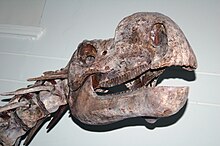Iguanodontia
| Iguanodontia | ||||||||||||
|---|---|---|---|---|---|---|---|---|---|---|---|---|

Skeleton reconstruction of Iguanodon bernissartensis in the Natural History Museum in London |
||||||||||||
| Temporal occurrence | ||||||||||||
| Middle Jurassic to Upper Cretaceous ( Callovian to Maastrichtian ) | ||||||||||||
| 166.1 to 66 million years | ||||||||||||
| Locations | ||||||||||||
|
||||||||||||
| Systematics | ||||||||||||
|
||||||||||||
| Scientific name | ||||||||||||
| Iguanodontia | ||||||||||||
| Dollo , 1888 |
The Iguanodontia were herbivorous, quadruped (four-legged) or biped (two-legged) moving dinosaurs that occurred on all continents from the Upper Jurassic to the late Upper Cretaceous . The group includes all bird basin dinosaurs that are more closely related to Edmontosaurus than to Thescelosaurus , including the well-known hadrosaurs .
description
Iguanodons were medium to large in size. The slightly built, bipedal Dryosaurus was about two to three meters long, Iguanodon , after which the whole group was named, reached a length of ten to eleven meters and weighed probably 2,500 kg. The heavily built Lurdusaurus is even given a weight of 5,000 kg.

The skull of most of the basal iguanodonts was elongated and somewhat flattened on the sides. Only Dryosaurus and Zalmoxes had a more compact, shorter skull. The lower skull window was oval, the eye socket round and without reinforcing bone plates. The nostrils were large. The number of teeth increased more and more from basal to advanced forms. In addition, the latter developed a beak on the premaxillary . Tenontosaurus and Zalmoxes had 10 to 12 teeth on the maxillary , in Dryosaurus it was 13 to 17, in Camptosaurus 14 to 16. Iguanodon had almost 30 teeth, Eolambia had 33.
Basically, all genera or species of Iguanodontia were characterized by their teeth. In contrast to most other dinosaurs, they were able to bite off their vegetable food with the front part of their snout and then chew it with their teeth .
Stratigraphic and geographic distribution
The first Iguanodont that can be reliably detected is Camptosaurus from the early Kimmeridgian of England and Dryosaurus from the Kimmeridgian of North America and Africa. In the Upper Jurassic, the group was widespread in Africa, Europe and North America. Even older from the Middle Jurassic ( Callovian ) is Callovosaurus , whose exact affiliation in the system has not yet been fully clarified. However, it shows features that are similar to the later Camptosaurus .
Finds from Asia, South America and Australia are also known from the early Cretaceous. During the Middle Cretaceous ( Albium to Cenomanium ) all of Laurasia was inhabited by Iguanodonts. In the last half of the late Cretaceous non-hadrosaurid iguanodonts with rhabdodon and zalmoxes only occurred in Europe. On all other continents they have been replaced by hadrosaurs. All iguanodonts died out with all other dinosaurs at the end of the Cretaceous 65.5 million years ago. Zalmoxes is the last fossil-proven genus.
Internal systematics of the basal Iguanodontia

left Ouranosaurus , Muttaburrasaurus , Corythosaurus ,
right two types of Lambeosaurus
-
Iguanodontia
- Tenontosaurus
- Rhabdodon
- Zalmoxes
-
Dryomorpha
- Dryosauridae
- Iguanodontoidea (= Hadrosauriformes)
literature
- David B. Norman : Basal Iguanodontia. In: David B. Weishampel , Peter Dodson , Halszka Osmólska (eds.): The Dinosauria . 2nd edition. University of California Press, Berkeley CA et al. 2004, ISBN 0-520-24209-2 , pp. 413-437.
Web links
- The Paleobiology Database
- Callovosaurus in the "Dinosaur Encyclopaedia"
Individual evidence
- ^ Gregory S. Paul : The Princeton Field Guide To Dinosaurs. Princeton University Press, Princeton NJ et al. 2010, ISBN 978-0-691-13720-9 , pp. 279–316, online ( memento of the original from July 13, 2015 in the Internet Archive ) Info: The archive link was automatically inserted and not yet checked. Please check the original and archive link according to the instructions and then remove this notice. .

